Rita and I again joined Ralph and Cheryl Waterhouse on an African safari. This was our fifth safari arranged by Ralph, the first being to Kenya in 1989 when he was director of the Kansas City Zoo. Trips to Zambia/Zimbabwe (1994) and Tanzania (1996) followed when Ralph was director of the Fresno Zoo. After retirement, Ralph has continued to lead trips and we joined him in South Africa in 2009 and this year in Zambia. We took a deep breath when the state department issued a travel alert warning of potential incidents arising from the hotly contested presidential race. However, the incumbent loser quickly embraced the victor and Zambia peaceably moved on. In contrast, safari tourism in neighboring Zimbabwe continues to suffer from the policies of President Robert Mugabe
Zambia/Dry Season. Ralph believes Zambia has some of the best concentration of game, and the peak density is during the dry season. Many of the lagoons and tributaries of the rivers dry up in the May-to-November dry season, and the animals converge on scarce water resources, particularly close to the major rivers. As Ralph advertised, the game was plentiful and the viewing was memorable. We would see only four of the “Big 5” (lion, leopard, buffalo, elephant and rhino) because the rhino population has been wiped out by poachers extracting the horns for Middle East daggers and Asian medicines of dubious value. Sad priorities. We saw all of the “Ugly 5” (hyena, wildebeest, vulture, warthog and marabou stork), and most of the “Green 5” and “Little 5” (if you really want to know, Google will tell you).The Camera. Our first three safaris were with film cameras, but by the time we went to South Africa two years ago, we had entered the wonderful world of digital. Take all the pics you want and get immediate feedback. We bought a Panasonic Lumix camera for that trip (18-power optical zoom) and got what we thought were good photos. However, two years is an eternity in today’s digital world and shopping maven Rita was on the lookout for a camera with a better zoom capability. She spotted an ad that touted the new Nikon Coolpix P500 (36-power) and rushed to Costco and bought it. Those in our party skilled with SLR, big lenses and manual controls no doubt got outstanding photos, but Rita and I are photographer underachievers of the point-and-shoot ilk and this Nikon was made for us. I used the Panasonic and together with Rita’s Nikon shots, we uploaded 2000 plus photos to Google’s Picasa cloud. We picked our favorites to create albums links, and when you open any album, either click the slideshow button or click twice on the first photo to bring it to screen size and use the arrow to surf through the photos at your own pace.
The Journey. We left our condo in KC at 10:00 on Monday morning, Sept. 26, and then via Atlanta, arrived at our hotel in Johannesburg at 7:00 Tuesday night. We gained 7 hours on the clock, and so the total travel time was 26 hours – 15 being on the overnight flight from Atlanta to JBG. The return two weeks later was similar with a door-to-door total of 30 hours. This was not the fun part of the trip. We joined our 15 fellow safari members in JBG, and 6 had been on our 2009 trip to South Africa (Ralph, Cheryl, Lou, Dena, Randy and Linda). We left the next morning for Zambia, first to the capital Lusaka, and then to a small airport in Mfuwe. We were picked up by the staff of Kapani Lodge and drove through the village (see the obligatory “Obama Pub”) to get to Kapani.

The Camps. We stayed two nights each at three camps operated by Norman Carr Safaris in South Luangwa National Park. The group then flew in two small planes to a landing strip near Chiawa Camp where we spent four nights in Lower Zambezi National Park. We concluded the trip with a flight from Chiawa to Livingstone for a two-day stay at Victoria Falls.
The routine was the same at each camp: wake-up knock at the door at 5:30; quick breakfast over an open fire; game drive or walk of about four hours; lunch/siesta; 3:30 tea time; afternoon game drive or walk with a stop for sundowner drinks, followed by a night drive until about 8:00; dinner. The staff at the camps outnumbered the guests by a good number. We were constantly amazed at the meals that could be served in the remote camps and were even treated to a lunch and a couple of torchlight dinners further out in the bush. The managers, guides, kitchen workers, security and other staff could not have been more attentive, and their respect for the animals and the environment is always on display.
The game drives were in open 4-wheel drive vehicles. Walkers were accompanied by a gun-toting ranger. Our eagle-eyed guides repeatedly impressed us with their ability to spot game. One of them, Abraham Banda, was named top guide in Zambia in 2009 and was one of three finalists in international competition in London in 2010. Lou, Dena, Ralph and Cheryl knew Abraham from prior trips and hosted him on a trip to the US a few years ago and have for many years provided support to a school in Mfuwe. We visited the school during our stay at Kapani and delivered school and athletic supplies.
Kapani Lodge. This lodge is the home base for Norman Carr Safaris and is close enough to Mfuwe to have mobile phone service and electricity from a utility – services not to be available in our other camps. Norman Carr, a young game warden who enjoyed tracking big game on foot, founded the company in 1950 to lead hunting and photo safaris. The hunting part was dropped years ago. Kapani is near the park entrance and our game drives were in the park along the hippo/crocodile-filled Luangwa River.
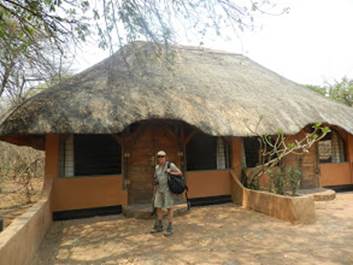
After Kapani, our party was divided into two groups to fit into the next two small bush camps, each of which featured tents with open air bathrooms. Bush camps are what the name implies – you are out in the bush, many miles from any village. The two camps had limited generator capacity and certainly not enough for ceiling fans in the tents as we had at Kapani. It was about 100 degrees, seriously interfering with afternoon naps and overnight sleeping. But the game viewing more than made up for this inconvenience.
Nsolo Camp. Rita and I had stayed at this location in 1994 and met Norman Carr at that time. He died in 1997. The old camp was destroyed by fire a few years ago and a new one has been built. The camp is not on a running river during the dry season, but small watering holes in the dry riverbed drew regular groups of animals, including a herd of elephants ambling through the middle of the camp. There is no sign to identify Nsolo in our camp album and so look for the frog on our bathroom mirror for the start of the Nsolo photos.

Mchenja Camp. This camp on a high bank above the Luangwa River offered a constant view of pods of hippos serenading us with their grunts and calls day and night. The money shots from the game drives at this camp were of a leopard feeding on an impala that he had killed and taken up a tree to keep it away from other predators (note the horns and dangling legs). We were treated to a night-time view of his “raw” meal, tongue-licking clean up and postprandial nap. A spotted hyena lurked on the ground below awaiting impala table scraps. Vultures would not be far behind to pick the bones.
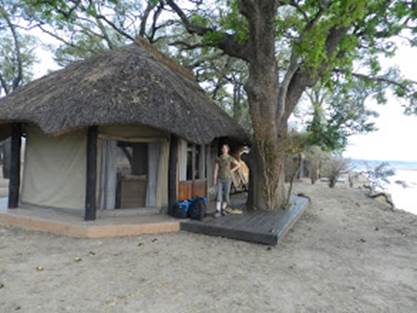
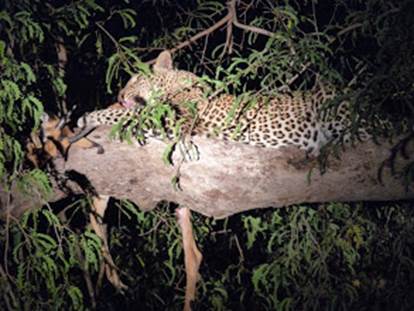
Chiawa Camp. We were reunited as a group of 17 at Chiawa, beautifully situated on the Zambezi river. The camp has a bigger generator and so we were back to ceiling fans, but they were hardly needed as the temperature dropped to an unseasonably cool 80 degrees. Nice. Our individual tents were identified by different African animals – Rita and I got the leopard tent. Alas, our tent marker was the only leopard we would see during our stay at Chiawa. In addition to game drives and walks, this camp offers canoeing, fishing and pontoon rides. Rita and I canoed the Zambezi in 1994 when we stayed at the nearby Ruckomechi Camp on the Zimbabwe side. After a submerged hippo came up and almost tipped over Rita’s canoe, we promptly converted to born-again pontoon riders. There are a lot of crocodiles in the river. Some in our party bravely (foolishly?) canoed at Chiawa and thankfully came back alive, with all limbs intact.
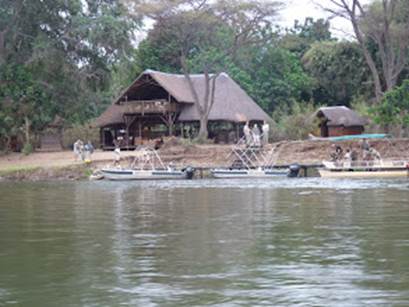
The primary subjects at Chiawa were the large elephant population and a photogenic 15-member lion pride. Elephants were often on the perimeter of the camp, and “Slash” came grazing through as we finished lunch one day (see the namesake hole in his ear). We were seated with Grant Cummings, the second generation owner of Chiawa, and he grabbed Rita’s camera and had us stand at the edge of the deck for photos with Slash. Other shots of Slash are “Table for One” and his image in the mirror at the entrance of the restaurant restroom. Other camp visitors were a snake (we prefer to not see snakes) and a lion roaring at night and evidenced the next day by paw tracks through the breakfast campfire area. As might be expected, we were not allowed to go without escort to and from our tents at night. Further proof of intimate elephant visits is the tree in the photo of our tent – note the bark is stripped off. Elephants can be very destructive with their inefficient eating/waste process and they have destroyed large swaths of bush areas.
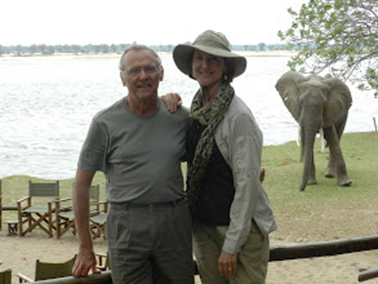
On a night drive, a spotter pans the area with a spotlight to catch the eye reflections of nocturnal animals. This often has the effect of freezing the animals until they can recover normal sight, potentially interfering with the movements of both predator and prey. At Chiawa (but not the other camps), the guides use a red filter on the spotlight that still gets the eye reflection, but does not affect the animal’s sight. The red filter is not photo friendly, but there is something to be said for not intruding on the natural activity. Our last night drive at Chiawa was quite productive (for viewing, not photos) with an almost full moon silhouetting the elephants and good views in the red filter light of two civets, two porcupines, a genet, a bush baby, a honey badger and an army of thousands (millions?) of Matabele ants crossing the road (we doubled back to avoid crushing them).
Camp Life: Click here.
[Important note. When you go to any of these links, you can click on the first photo and it turns into a slide show with notes.]
Safari guests on game walks/drives/cruises: Click here.
The African Game. This album starts with the varieties of antelope, very pretty animals in contrast to the warthogs that follow (an “Ugly 5” member considered cute by many in our party). One of our favorite lion sightings was a mother at a den attempting to move her cubs to a different location. She carried one about 50 yards away and came back to get the next one. The first one followed her back, and so the mother worked on enlarging the den opening and tried to get them to follow her. No dice for the 15 minutes we watched. The last series of lions in this album are the Chiawa pride who we first saw taking turns feeding on a Cape buffalo. The day after that gluttonous feeding found most of them lethargic and dozing under trees. There was some activity from two playful cubs and also two adults who climbed a tree to get away from bugs on the ground. You will be able to see damage to the mouth and nose area of one of the lions, caused by eating prey with anthrax. The hippos, elephants and buffalo sometimes get anthrax in the dry season and a few were dying off. This is not usually a serious issue unless the disease is passed along to small population species like the lions. Lions are often immune to certain anthrax strains, but the Chiawa pride was not immune to the current strain. The good news is that the lions were darted to knock them out so that a vet could immunize them, and it appears all 15 of the pride will survive. Click here.
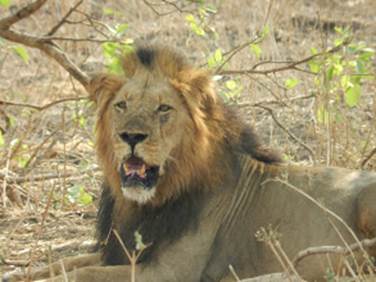
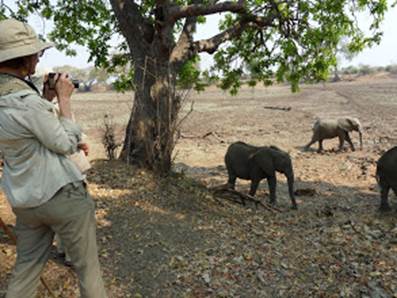
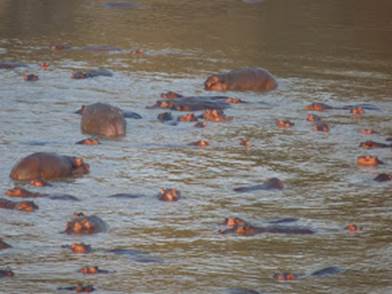
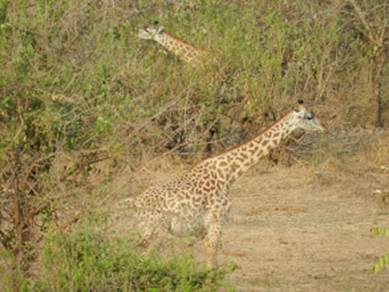
The Birds. The most diverse and colorful animals are the birds. The album starts with the Lilac-Breasted Roller, the consensus favorite of African bird watchers. It also has great wing colors when flying, especially males diving to impress females, but an awful sounding call. Next is a dropwing dragonfly – not a bird, but it does fly. Look closely at the next photo – the Saddle-billed Stork has just plucked a snake out of the marsh. The next group shows various types of bee-eaters, beautiful little birds living in large boisterous colonies. They create nests by boring holes in sandy cliffs exposed when the river is down in the dry season. After the eggs are hatched, the birds migrate and the rising river takes out the nests. The next year, they come back and start all over again. Just as fascinating are the even smaller Red-billed Queleas (less than an ounce each) who swarm in choreographed formations from ground to tree to sky in flocks of thousands (sometimes millions). The “whoosh” sounds and synchronized ballet movements of the queleas are mesmerizing. Click here.
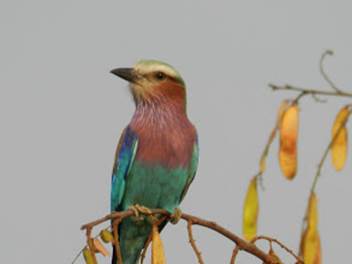
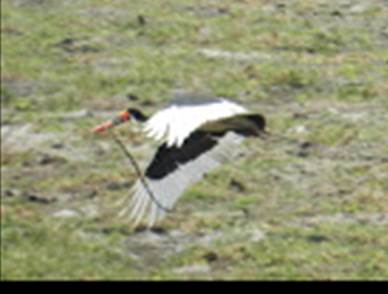
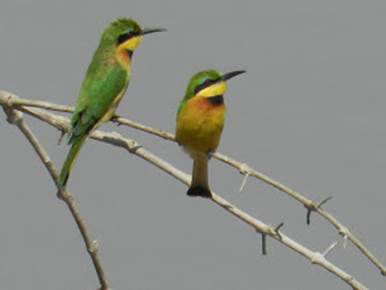
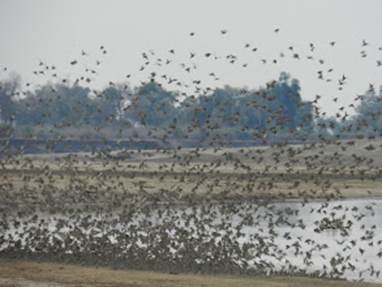
Victoria Falls. The native name is Mosi-oa-Tunya (“Smoke that Thunders”). Hence, the local beer named Mosi. Our best view of the falls came from 3000 feet when we flew into Livingstone and the pilot of our small plane treated us to a flyover. We stayed at the very nice Royal Livingstone Hotel at the crest of the falls on the Zambia side. This was a short walk to the eastern cataract of the falls. The better view and more cataracts are on the Zimbabwe side as we had seen when we stayed on that side in 1994. Being the dry season, the water flow is at a relatively low volume. Click here.
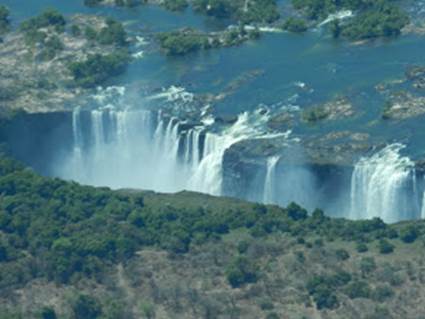
Botswana Excursion. We had a full extra day at Victoria Falls, and most of the party headed to the Zimbabwe side to shop and see the other cataracts. Being Lonnie and Rita, we noted that we were close to Botswana’s famous Chobe National Park and we could add a new country (#110) with a day trip. No visa was required, but we did need to go through immigration at the chaotic Kazangula border station at the confluence of the Chobe and Zambezi rivers, crossroads for four countries: Botswana, Zambia, Namibia and Zimbabwe.
At Chobe Safari Lodge, we started with a pontoon cruise and first went directly across the Chobe River and beached on the other side to photograph some elephants. Our guide informed us that we had landed in Namibia, surprisingly giving us country #111 (shortest country visit ever, about 5 minutes, and no passport stamp). We continued up the river to Sedudu Island, which is submerged in the rainy season, but emerges as a Garden of Eden during the dry season when a large number and variety of animals wade and swim across to graze on the fresh vegetation. The island was the subject of a border dispute with Namibia as both countries wanted the island for tourism. In 1999, an arbitrator ruled in favor of Botswana, and to publicize that decision, a blue Botswana flag flies over the island.
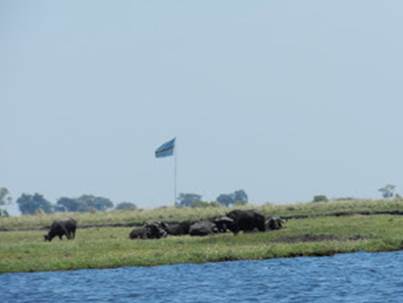
Our cruise around the island netted views of many elephants and hippos, several crocodiles, warthogs and red lechwe (an antelope that we did not see in Zambia), good pics of water monitor lizards, a 300-plus herd of Cape buffalo and a variety of birds. A big treat was a herd of 15 elephants wading across to the island in front of our pontoon.
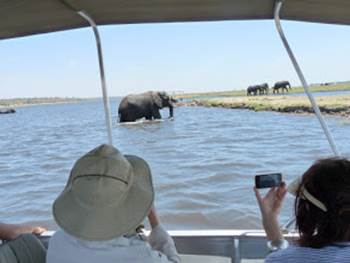
After lunch at the lodge, we took a game drive on the mainland side. The very large Chobe National Park has about 60,000 elephants, and we saw several hundred in our drive. Our guide said that sundown would bring thousands to the river. We had good giraffe sightings, including the always enjoyable yoga-like poses while drinking. And a new antelope, the elegant sable. Click here.
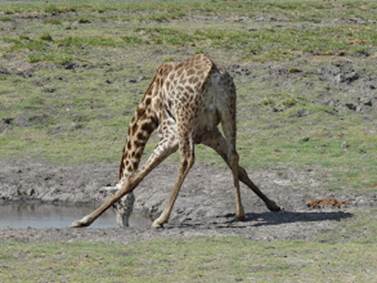
The Final Night. We returned from Chobe to our hotel just before sunset and headed to the riverside deck overlooking the crest of Victoria Falls. We joined Randy and Linda for sundowners to toast the sunset over the mist of the falls. Click here.
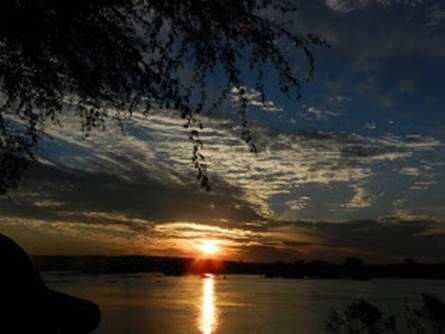
Portraits of Zambia. Rita set up an album of close-ups, starting with cute stand-up photos of a banded mongoose and a tree squirrel plus a hard-to-get shot of a tiny elephant shrew. Click here.
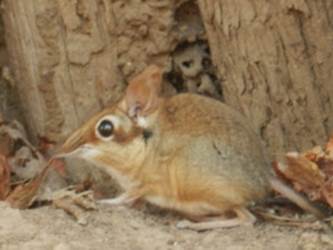
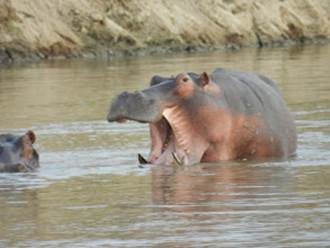
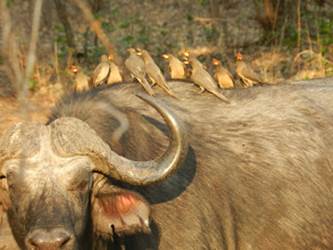
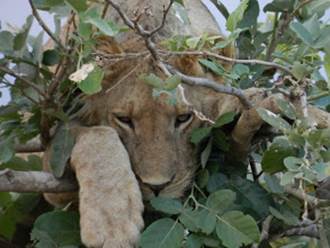
Video Shorts: Our new camera also has a video option, although our results were way short of National Geographic.
But, some fun memories: 1. Chiawa staff singing to us. 2. Lion cub. 3. Elephants joining us for sundowners. 4. Leopard at dinner. 5. Elephants crossing river in Botswana. 6. Dance of the Red-billed Queleas. 7. Songs of the Carmine Bee-eater colony. 8. Grin of the hyena. 9. Lion in a tree. 10. Unhappy elephants. 11/12. Victoria Falls from air and ground. Click here.
Still the Best: Confirming a conclusion we first reached in 1989, Rita and I continue to place a bush game drive at the top of our list of favorite vacation adventures.
We hope you enjoy this armchair version of the safari.
Lonnie and Rita